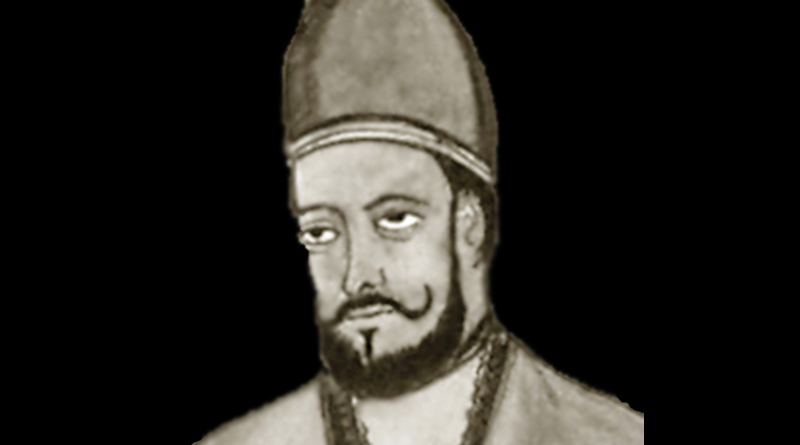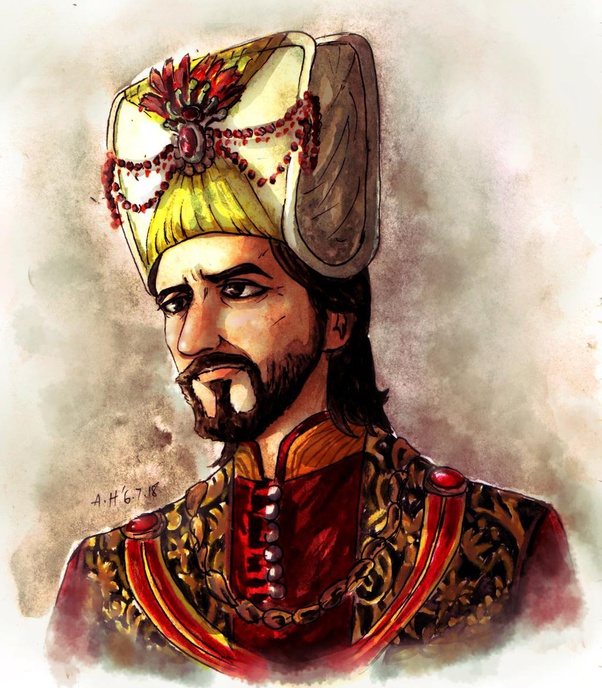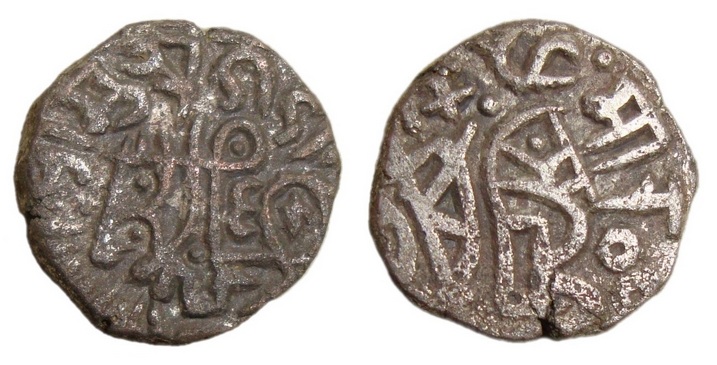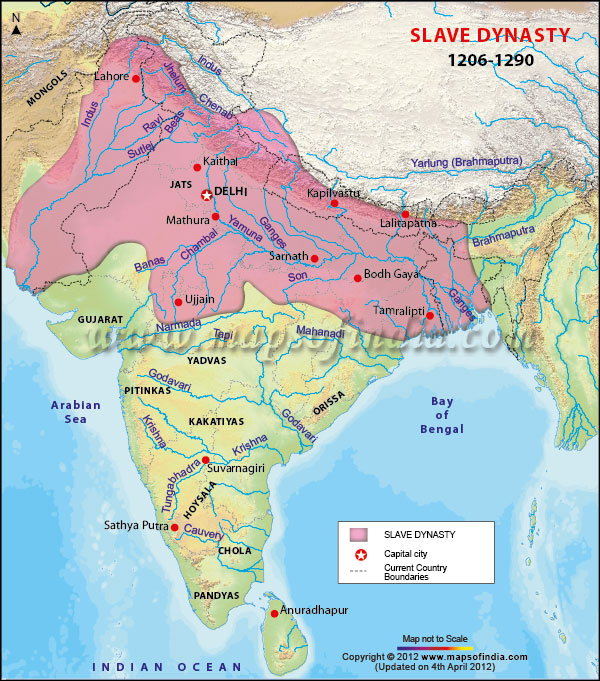The Slave dynasty was the first Muslim dynasty to rule India. Muhammad Ghori did not have a natural heir to the throne and he used to treat his slaves as his own children. So after the death of Ghori, one of the able slaves Qutubuddin Aibak took the throne. The history of the slave dynasty begins with the rule of Qutub-ud-din Aibak. In fact, three dynasties were established during this period. They were, Qutub dynasty (c. 1206-1211 CE) was founded by Qutubddin Aibak, First Ilbari dynasty (c.1211-1266 CE) founded by Iltumish, and Second Ilbari dynasty (c. 1266-1290 CE) founded by Balban.
Founder of Slave Dynasty: Qutub-ud-din Aibak (c.1206-10 CE)
He was the founder of the Slave dynasty. He was a Turkish Slave of Muhammad Ghori, who played an important role in the expansion of the Turkish Sultanate in India and was made the governor of Ghori.

After the death of Ghori in c. 1206 CE, Tajuddin Yaldauz, the ruler of Ghazni, claimed his rule over Delhi and Nasiruddin Qabacha, the governor of Multan and Uchch aspired for independence. Along with this all, he also had to face many revolts from Rajputs and other Indian chiefs. The successor of Jaichand, Harishchandra, had driven out the Turks from Badayun and Farukhabad.
Aibak was able to win over his enemies by conciliatory measures as well as a display of power. He defeated Yaldauz and severed all connections with Ghazni. Aibak also re-conquered both Badayun and Farukhabad and thus founded the Slave dynasty as well as Delhi Sultanate. He took the title of ‘Sultan’ and made Lahore his capital. He did not issue any coins and was formally recognized after three years. Due to his good nature, he earned the title of “Lakh Baksh“, which means giver of thousands. He built the first mosque in India – Quwwat-ul-Islam (Delhi). He also commissioned Arahi din ka jhonpara (Ajmer).
He patronized great scholar Hasan Nizami – Taj-ul-Massir and Fakih-ul-din – Tarikh-i-Mubarakshahi. He started construction of Qutub Minar (only 1st floor) in the memory of the famous Sufi saint, Khwaja Qutubddin Bakthiyar Kaki. It was later completed by Iltumish. Aibak died suddenly in c.1210 CE while playing Chaugan (Horse Polo).
Aramshah (c.1210 CE)
He was the son of Qutubddin Aibak, who succeeded his father but was an incapable ruler, and a weak and worthless young man. The Turkish amirs opposed him. He ruled mere eight months. The Turkish chiefs of Delhi invited the governor of Badayun, Iltumish (son-in-law of Qutubddin Aibak), to come to Delhi. Iltumish disposed of Aram Shah and became the Sultan with the name of Shamsuddin.
The First Ilbari Dynasty: Iltutmish (c. 1210-1236 CE)
The real founder refers to rulers who protect an established state from various internal & external challenges, provide a political-administration & economic base of such strength that the existence of this political entity doesn’t face any serious threat in the future. According to some theories, he was the slave of Qutub din Aibak.

When Iltutmish set on the throne in c.1210 CE, the newly established Turkish Indian Empire was facing several serious challenges to its existence. Rajputana had thrown away the yoke of Turkish rule, revolts & rebellion were rampant & external claimants were emphasizing sovereignty. Sultan Iltutmish responded to challenges in a determined manner by adopting a multipronged strategy. Iltutmish transformed the loosely patched up Turkish Indian territories into a coherent empire. He shifted his capital from Lahore to Delhi.
To provide a solid administrative foundation to Sultanate, he created Turkan-i-chihalgai & reorganized the Iqta system. He was the 1st Sultan of Delhi to define the duties & responsibilities of Iqtadar. Iltutamish created Hasham-i-Qalb & Sar-i-Jandar. Hasham-i-Qalb was a body of troops comprising cavalrymen. It was placed directly under command of the Sultan.
Sar-i-Jandar institution of the royal bodyguard. To strengthen the economic foundation of the Delhi Sultanate, Iltutamish issued pure Arabic coins. The silver coin issued by him was known as Tanka & Jital was copper. This monetization of the economy held in the growth of trade & commerce. Iltutamish reconquered the rebellious territories to ensure that the command of the Sultan was effective throughout the empire. Jalore, Ranthambhor, Ajmer, Mandor were reconquered by him.
The rebellious element was suppressed by him at Banaras, Badayun, and Kannauj & Kateher to strengthen the Sultanate internally. Iltutmish defeated Qabacha of Sindh in c.1217 CE & Yaldauj of Ghurids in c.1215 CE to establish the sovereignty of Delhi. Hereafter no external force claimed right over the throne of Delhi. Iltutmish saved the Delhi Sultanate from Major menace by his diplomacy. He also initiated steps to provide a solid cultural foundation to the Delhi Sultanate.
Several scholars were recognition by him in his court among these scholars Meenaj-ud-din Siraj the author of Tabagat-i-Nasiri was the greatest. His authority was recognized by the Abbasid Caliph of Baghdad in c.1229 CE as he received the Mansur, by which he became the legal sovereign ruler of India. The cultural prestige of Delhi was so high that it assume popularity as Hajrat-i-Delhi. When Iltutmish died in c.1236 CE there was peace & stability all around. No serious threat haunting the Sultan that is why he knows as the real founder of the Delhi Sultanate.
Ruknuddin Firuz Shah (c. 1236 CE)
Sultan Iltutmish was aware that the debased character of sons, he was convinced that Razia would make a great ruler. But Shamshi Noble placed Ruknuddin Firuz Shah on the throne after Iltumish as they wanted to keep powers in their hands. He was the eldest son of Iltumish who was put on the throne by nobles.
He took rides on elephants in Delhi distributing gold and the government was handled by Shah Turkan. When the governor of Multan revolted, Ruknuddin marched to suppress that revolt. Using this opportunity, Razia, with the support of amirs of Delhi, seized the throne of the Delhi Sultanate. Both Firuz Shah and Shah Turkan were put to death.
Razia Sultan (c. 1236-1239 CE)

In the long history of almost 700 years of Turko-Afghan & Mughal Rulers, Razia was the only woman to sit on the throne of Delhi. She was the daughter of Sultan Iltutmish. She was highly educated courageous. She began to adorn herself in male attire and rode out in public on an elephant, went hunting, and led the army. This aroused resentment among the Turkish nobles.
She discarded female apparel and purdah. She used to participate in court activities like a princess. Razia was tolerant broadminded & believed firmly in the principle of impartial justice irrespective of the status of the offender tough punishment was given to everybody. Razia’s attempt to create counter nobility of non-Turkish invited the wrath of the Turkish amirs. Her decision to appoint an Abyssian slave, Malik Jamaluddin Yaqut, to the important office of the Amir-i-akhur (Superintendent of royal horses).
Razia had the quality of a military commandant. She planned & undertook a military campaign to reconquer for Ranthambhor captured by Rajput.
Reasons for the downfall of Razia
In c.1240 CE, a serious rebellion broke out in Sirhind (Bhatinda) under Altuniya (governor). Razia alongside Yaqut marched against Altuniya, but on the way, Turkish followers of Altuniya murdered Yaqut and imprisoned Razia. In the meantime, the Turkish nobles put Bahram, another son of Iltumish, on the throne. However, Razia won over her captor, Altuniya, and after marrying him, she proceeded to Delhi. But she was defeated and killed on the way by Bahram Shah.
The historians attributed different reasons for the downfall of Sultana Razia. Generally, it’s emphasizing that her gender was the biggest problem. The Shamsi Nobel opposed her because of gender. But such justification doesn’t represent reality. The rule of Razia by Shamsi Nobel, because she refused, became the puppet of their hand. She wanted to be a ruler both in the name & in fact. She determined to decide state matters & to guide political & military affairs that discarded the theory of being female on the Sultanate throne.
Bahram Shah (c. 1240–42 CE)

He was the son of Iltutmish and the half-brother of Razia Sultan. While his sister was in Bathinda, he declared himself Sultan with the support of forty chiefs. His sister tried to regain the throne with the aid of her husband Altuniya, a chief of Bathinda, though they were eventually arrested and executed.
Even so, during Muiz ud din Bahram’s two years as king, the chiefs that had originally supported him became disordered and constantly bickered among each other. It was during this period of unrest that he was murdered by his own army in c.1242 CE. After his death, he was succeeded by his nephew Alauddin Masud, a son of his half-brother Ruknuddin Firuz.
Alauddin Masud Shah (c. 1242-46 CE)
He was the son of Rukn ud-Din Firuz (1236), grandson of Shah Turkan, and the nephew of Raziya al-Din (1236–40). After his predecessor and uncle, Muiz ud-Din Bahram was murdered by the army in 1242 after years of disorder, the chiefs chose for him to become the next ruler.
However, he was more of a puppet for the chiefs and did not actually have much power or influence in the government. Instead, he became infamous for his fondness for entertainment and wine. Like his predecessor, he was considered “incompetent and worthless.” By 1246, the chiefs became upset with his increasing hunger for more power in the government and replaced him with his cousin Nasir ud din Mahmud, grandson of Iltutmish through his son Nasiruddin Mahmud.
Nasiruddin Mahmud (c.1246-65 CE)
Grandson of Iltumish who was inexperienced and young and had ascended to the throne with the aid of Ulugh Khan/Balban (a member of Chahalgani), who himself assumed the position of Naib. To further strengthen his position, he married his daughter to Nasiruddin. The real power during Mahmud’s reign lay in the hands of Balban.
The growing authority of Balban alienated many of the Turkish chiefs and with a conspiracy in c.1250 CE, they ousted Balban from his position and replaced him with Imaduddin Raihan, who was an Indian Muslim, as they could not agree among themselves which Turkish noble should succeed Balban’s post. Balban agreed to step aside but carefully build his own group, and within a short span of one and a half years, won over some of his opponents.
In due course of time, Balban was reinstated with even more powers and he even assumed the royal insignia. Mahmud died in c.1265 CE, and according to some historians such Ibn Batuta and Isami, Balban poisoned his master Nasiruddin and ascended the throne.

